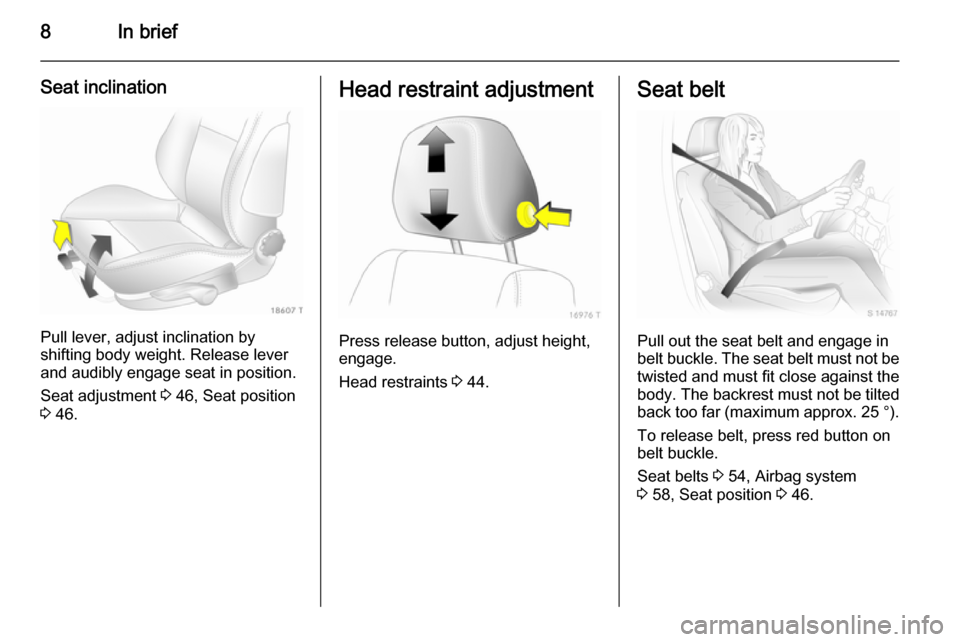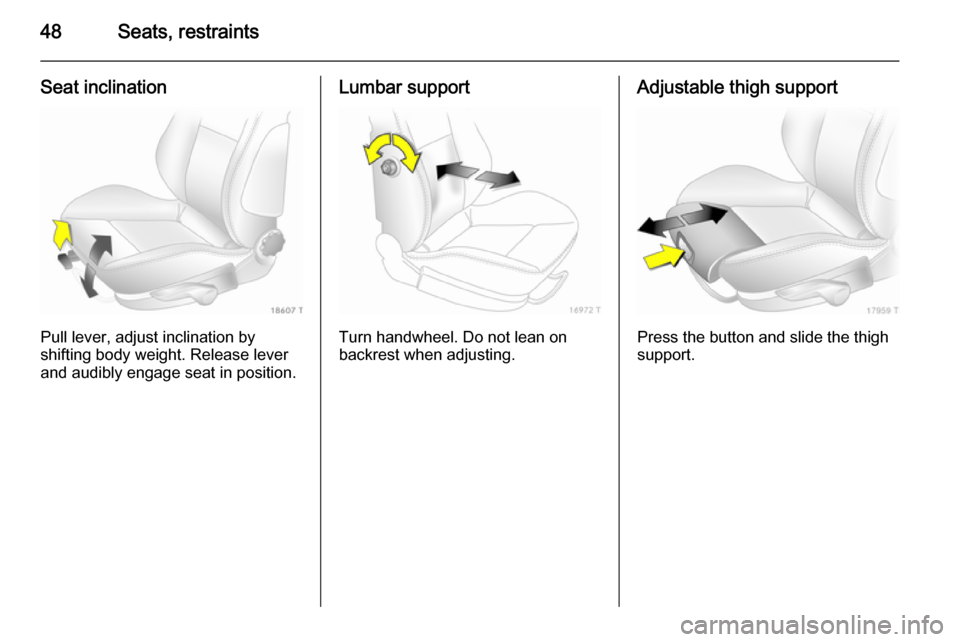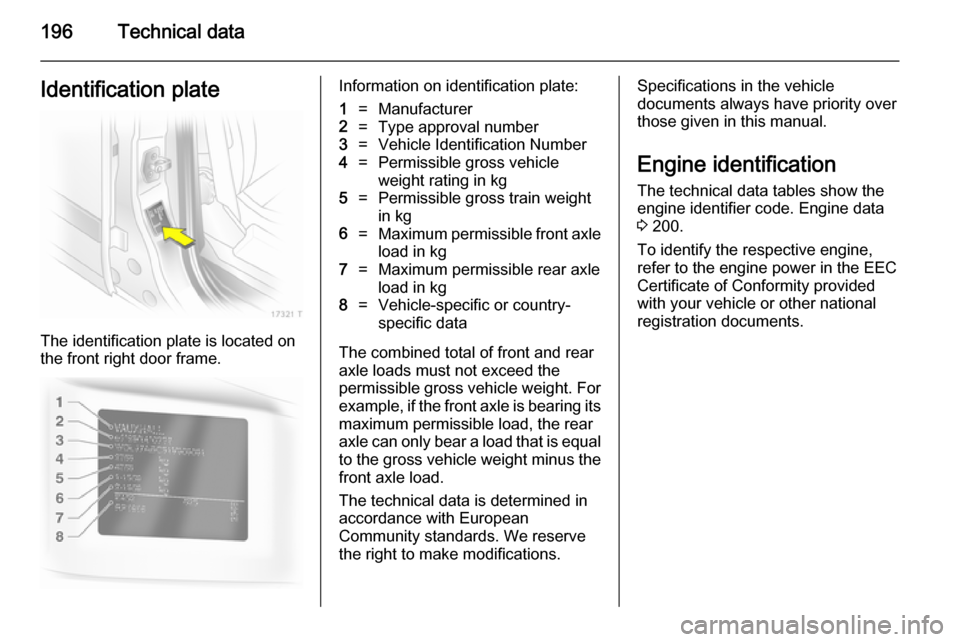weight VAUXHALL ZAFIRA 2014 Owner's Manual
[x] Cancel search | Manufacturer: VAUXHALL, Model Year: 2014, Model line: ZAFIRA, Model: VAUXHALL ZAFIRA 2014Pages: 217, PDF Size: 7.85 MB
Page 10 of 217

8In brief
Seat inclination
Pull lever, adjust inclination by
shifting body weight. Release lever
and audibly engage seat in position.
Seat adjustment 3 46, Seat position
3 46.
Head restraint adjustment
Press release button, adjust height,
engage.
Head restraints 3 44.
Seat belt
Pull out the seat belt and engage in
belt buckle. The seat belt must not be twisted and must fit close against the
body. The backrest must not be tilted
back too far (maximum approx. 25 °).
To release belt, press red button on
belt buckle.
Seat belts 3 54, Airbag system
3 58, Seat position 3 46.
Page 50 of 217

48Seats, restraints
Seat inclination
Pull lever, adjust inclination by
shifting body weight. Release lever
and audibly engage seat in position.
Lumbar support
Turn handwheel. Do not lean on
backrest when adjusting.
Adjustable thigh support
Press the button and slide the thigh
support.
Page 64 of 217

62Seats, restraints
Suitable are restraint systems that
comply with ECE 44-03 or
ECE 44-04. Check local laws and
regulations for mandatory use of child restraint systems.
Never hold a child whilst travelling in
the vehicle. The child will become too
heavy to be held in the event of a
collision.
When transporting children, use the
child restraint systems suitable for the
child's weight.
Ensure that the child restraint system to be installed is compatible with the
vehicle type.
Ensure that the mounting location of
the child restraint system within the
vehicle is correct.
Allow children to enter and exit the vehicle only on the side facing away
from the traffic.
When the child restraint system is not in use, secure the seat with a seat beltor remove it from the vehicle.Notice
Do not affix anything on the child
restraint systems and do not cover
them with any other materials.
A child restraint system which has
been subjected to stress in an
accident must be replaced.
Page 65 of 217

Seats, restraints63Child restraint installation locationsPermissible options for fitting a child restraint system
Weight and age class 1)
On front passenger
seatOn outboard
seats in the
second rowOn centre seat
in the second
rowOn the seats
in the third
rowGroup 0: up to 10 kg or approx. 10 months
Group 0+: up to 13 kg or approx. 2 yearsXU, +UXGroup I: 9 to 18 kg or approx. 8 months to 4 yearsXU, +, ++UUFGroup II: 15 to 25 kg or approx. 3 to 7 years
Group III: 22 to 36 kg or approx. 6 to 12 yearsXUUUFU=Universal suitability in conjunction with three-point seat belt.UF=Can be used universally for forward-facing child restraint systems in combination with a three-point seat belt.+=Vehicle seat available with ISOFIX attachments. When attaching using ISOFIX, only the ISOFIX child restraint
systems permitted for the vehicle may be used.++=Vehicle seat available with ISOFIX attachments. When attaching using ISOFIX and Top-tether , universally permitted
ISOFIX child restraint systems may be used.X=No child restraint system permitted in this weight class.1) We recommend the use of each system until the child reaches the upper weight limit.
Page 66 of 217

64Seats, restraints
Permissible options for fitting an ISOFIX child restraint systemWeight classSize classFixtureOn front passenger
seatOn outboard seats
in the second rowOn centre seat in
the second rowOn the seats in
the third rowGroup 0: up to 10 kgEISO/R1XILXXGroup 0+: up to 13 kgEISO/R1XILXXDISO/R2XILXXCISO/R3XILXXGroup I: 9 to 18 kgDISO/R2XILXXCISO/R3XILXXBISO/F2XIL, IUFXXB1ISO/F2XXIL, IUFXXAISO/F3XIL, IUFXXIL=Suitable for particular ISOFIX restraint systems of the "specific-vehicle", "restricted" or "semi-universal" categories.
The ISOFIX restraint system must be approved for the specific vehicle type.IUF=Suitable for ISOFIX forward-facing child restraint systems of universal category approved for use in this weight class.X=No ISOFIX child restraint system approved in this weight class.
Page 67 of 217

Seats, restraints65
ISOFIX size class and seat deviceA – ISO/F3=Forward-facing child restraint system for children of maximum size in the weight class 9 to 18 kg.B – ISO/F2=Forward-facing child restraint system for smaller children in the weight class 9 to 18 kg.B1 – ISO/F2X=Forward-facing child restraint system for smaller children in the weight class 9 to 18 kg.C – ISO/R3=Rear-facing child restraint system for children of maximum size in the weight class up to 18 kg.D – ISO/R2=Rear-facing child restraint system for smaller children in the weight class up to 18 kg.E – ISO/R1=Rear-facing child restraint system for young children in the weight class up to 13 kg.
Page 78 of 217

76Storage
■ When transporting objects in theload compartment, the backrests of
the second row must not be angled forward.
■ Do not allow the load to protrude above the upper edge of the
backrests.
■ Do not place any objects on the load compartment cover or theinstrument panel.
■ The load must not obstruct the operation of the pedals, parking
brake and gear selector, or hinder
the freedom of movement of the
driver. Do not place any unsecured
objects in the interior.
■ Do not drive with an open load compartment.9 Warning
Always make sure that the load in
the vehicle is securely stowed.
Otherwise objects can be thrown
around inside the vehicle and
cause personal injury or damage
to the load or car.
■ The payload is the difference between the permitted gross
vehicle weight (see identification
plate 3 196) and the EC kerb
weight.
To calculate the payload, enter the
data for your vehicle in the Weights
table at the front of this manual.
The EC kerb weight includes
weights for the driver (68 kg),
luggage (7 kg) and all fluids (tank
90 % full).
Optional equipment and
accessories increase the kerb
weight.
■ Driving with a roof load increases the sensitivity of the vehicle to
cross-winds and has a detrimental
effect on vehicle handling due to
the vehicle's higher centre of
gravity. Distribute the load evenly
and secure it properly with retaining
straps. Adjust the tyre pressure and vehicle speed according to the load
conditions. Check and retighten the
straps frequently.
Do not drive faster than 75 mph.The permissible roof load is 75 kg and 100 kg for vehicles with roof
railing. The roof load is the
combined weight of the roof rack
and the load.
Page 148 of 217

146Driving and operating
For the values specific to your
vehicle, refer to the EEC Certificate of Conformity provided with your vehicle
or other national registration
documents.
General information The official fuel consumption and
specific CO 2 emission figures quoted
relate to the EU base model with
standard equipment.
Fuel consumption data and CO 2
emission data are determined
according to regulation
R (EC) No. 715/2007 (in the latest
applicable version), taking into
consideration the vehicle weight in
running order, as specified by the
regulation.
The figures are provided only for the
purpose of comparison between
different vehicle variants and must
not be taken as a guarantee for the
actual fuel consumption of a
particular vehicle. Additional
equipment may result in slightly
higher results than the stated
consumption and CO 2 figures.Furthermore, fuel consumption is
dependent on personal driving style
as well as road and traffic conditions.
Natural gas
The fuel consumption information
was obtained using reference fuel
G20 (methane proportion
99 - 100 mol%) under prescribed
driving conditions. When using
natural gas with a lower proportion of
methane, the fuel consumption can
differ from the specified values.Trailer hitch
General information
Only use towing equipment that has
been approved for your vehicle.
Entrust retrofitting of towing
equipment to a workshop. It may be
necessary to make changes that
affect the cooling system, heat
shields or other equipment.
Fitting of towing equipment could
cover the opening of the towing eye.
If this is the case, use the coupling ball
bar for towing. Always keep the
coupling ball bar in the vehicle.
Installation dimensions of factory-
fitted towing equipment 3 207.
Driving characteristics and towing tips Before attaching a trailer, lubricate
the coupling ball. However, do not do
so if a stabiliser, which acts on the
coupling ball, is being used to reduce snaking movements.
Page 149 of 217

Driving and operating147
For trailers with low driving stability
and trailers with a permitted gross
vehicle weight of more than 1300 kg a speed of 50 mph must not be
exceeded; the use of a stabiliser is
recommended.
If the trailer starts snaking, drive more slowly, do not attempt to correct the
steering and brake sharply if
necessary.
When driving downhill, drive in the
same gear as if driving uphill and
drive at a similar speed.
Adjust tyre pressure to the value
specified for full load 3 205.
Trailer towing Trailer loads
The permissible trailer loads are
vehicle and engine-dependent
maximum values which must not be
exceeded. The actual trailer load is
the difference between the actual
gross weight of the trailer and the
actual coupling socket load with the
trailer coupled.The permissible trailer loads are
specified in the vehicle documents. In general, they are valid for gradients
up to max. 12 %
The permitted trailer load applies up to the specified incline and up to an
altitude of 1000 metres above sea
level. Since engine power decreases
as altitude increases due to the air becoming thinner, therefore reducing
climbing ability, the permissible gross
train weight also decreases by 10 %
for every 1000 metres of additional
altitude. The gross train weight does
not have to be reduced when driving
on roads with slight inclines (less than 8 %, e. g. motorways).
The permissible gross train weight
must not be exceeded. This weight is
specified on the identification plate
3 196.
Vertical coupling load
The vertical coupling load is the load
exerted by the trailer on the coupling
ball. It can be varied by changing the
weight distribution when loading the
trailer.The maximum permissible vertical
coupling load (75 kg) is specified on
the towing equipment identification
plate and in the vehicle documents.
Always aim for the maximum load,
especially in the case of heavy
trailers. The vertical coupling load
should never fall below 25 kg.
Rear axle load When the trailer is coupled and the
towing vehicle fully loaded, the
permissible rear axle load (see
identification plate or vehicle
documents) may be exceeded by 90 kg and the gross vehicle weight
rating by 75 kg. If the permissible rear
axle load is exceeded, a maximum
speed of 62 mph applies.
Towing equipmentCaution
When operating without a trailer,
remove the coupling ball bar.
Page 198 of 217

196Technical dataIdentification plate
The identification plate is located on
the front right door frame.
Information on identification plate:1=Manufacturer2=Type approval number3=Vehicle Identification Number4=Permissible gross vehicle
weight rating in kg5=Permissible gross train weight
in kg6=Maximum permissible front axle load in kg7=Maximum permissible rear axle
load in kg8=Vehicle-specific or country-
specific data
The combined total of front and rear
axle loads must not exceed the
permissible gross vehicle weight. For
example, if the front axle is bearing its
maximum permissible load, the rear
axle can only bear a load that is equal
to the gross vehicle weight minus the front axle load.
The technical data is determined in
accordance with European
Community standards. We reserve
the right to make modifications.
Specifications in the vehicle
documents always have priority over
those given in this manual.
Engine identification
The technical data tables show the
engine identifier code. Engine data
3 200.
To identify the respective engine,
refer to the engine power in the EEC
Certificate of Conformity provided
with your vehicle or other national
registration documents.